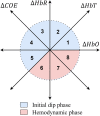Vector Phase Analysis Approach for Sleep Stage Classification: A Functional Near-Infrared Spectroscopy-Based Passive Brain-Computer Interface
- PMID: 33994983
- PMCID: PMC8121150
- DOI: 10.3389/fnhum.2021.658444
Vector Phase Analysis Approach for Sleep Stage Classification: A Functional Near-Infrared Spectroscopy-Based Passive Brain-Computer Interface
Abstract
A passive brain-computer interface (BCI) based upon functional near-infrared spectroscopy (fNIRS) brain signals is used for earlier detection of human drowsiness during driving tasks. This BCI modality acquired hemodynamic signals of 13 healthy subjects from the right dorsolateral prefrontal cortex (DPFC) of the brain. Drowsiness activity is recorded using a continuous-wave fNIRS system and eight channels over the right DPFC. During the experiment, sleep-deprived subjects drove a vehicle in a driving simulator while their cerebral oxygen regulation (CORE) state was continuously measured. Vector phase analysis (VPA) was used as a classifier to detect drowsiness state along with sleep stage-based threshold criteria. Extensive training and testing with various feature sets and classifiers are done to justify the adaptation of threshold criteria for any subject without requiring recalibration. Three statistical features (mean oxyhemoglobin, signal peak, and the sum of peaks) along with six VPA features (trajectory slopes of VPA indices) were used. The average accuracies for the five classifiers are 90.9% for discriminant analysis, 92.5% for support vector machines, 92.3% for nearest neighbors, 92.4% for both decision trees, and ensembles over all subjects' data. Trajectory slopes of CORE vector magnitude and angle: m(|R|) and m(∠R) are the best-performing features, along with ensemble classifier with the highest accuracy of 95.3% and minimum computation time of 40 ms. The statistical significance of the results is validated with a p-value of less than 0.05. The proposed passive BCI scheme demonstrates a promising technique for online drowsiness detection using VPA along with sleep stage classification.
Keywords: brain-computer interface; cerebral oxygen regulation; drowsiness detection; feature selection; functional near-infrared spectroscopy; multiclass classification; sleep stages; vector phase analysis.
Copyright © 2021 Arif, Khan, Naseer, Hong, Sajid and Ayaz.
Conflict of interest statement
The authors declare that the research was conducted in the absence of any commercial or financial relationships that could be construed as a potential conflict of interest.
Figures









Similar articles
-
Applying antagonistic activation pattern to the single-trial classification of mental arithmetic.Heliyon. 2022 Oct 20;8(10):e11102. doi: 10.1016/j.heliyon.2022.e11102. eCollection 2022 Oct. Heliyon. 2022. PMID: 36303917 Free PMC article.
-
Driving drowsiness detection using spectral signatures of EEG-based neurophysiology.Front Physiol. 2023 Mar 30;14:1153268. doi: 10.3389/fphys.2023.1153268. eCollection 2023. Front Physiol. 2023. PMID: 37064914 Free PMC article.
-
Passive BCI based on drowsiness detection: an fNIRS study.Biomed Opt Express. 2015 Sep 22;6(10):4063-78. doi: 10.1364/BOE.6.004063. eCollection 2015 Oct 1. Biomed Opt Express. 2015. PMID: 26504654 Free PMC article.
-
Enhancing classification accuracy of fNIRS-BCI using features acquired from vector-based phase analysis.J Neural Eng. 2020 Oct 15;17(5):056025. doi: 10.1088/1741-2552/abb417. J Neural Eng. 2020. PMID: 33055382
-
Feature Extraction and Classification Methods for Hybrid fNIRS-EEG Brain-Computer Interfaces.Front Hum Neurosci. 2018 Jun 28;12:246. doi: 10.3389/fnhum.2018.00246. eCollection 2018. Front Hum Neurosci. 2018. PMID: 30002623 Free PMC article. Review.
Cited by
-
EEG electrode setup optimization using feature extraction techniques for neonatal sleep state classification.Front Comput Neurosci. 2025 Jan 31;19:1506869. doi: 10.3389/fncom.2025.1506869. eCollection 2025. Front Comput Neurosci. 2025. PMID: 39959920 Free PMC article.
-
Applying antagonistic activation pattern to the single-trial classification of mental arithmetic.Heliyon. 2022 Oct 20;8(10):e11102. doi: 10.1016/j.heliyon.2022.e11102. eCollection 2022 Oct. Heliyon. 2022. PMID: 36303917 Free PMC article.
-
Driving drowsiness detection using spectral signatures of EEG-based neurophysiology.Front Physiol. 2023 Mar 30;14:1153268. doi: 10.3389/fphys.2023.1153268. eCollection 2023. Front Physiol. 2023. PMID: 37064914 Free PMC article.
-
Deciphering Post-Stroke Sleep Disorders: Unveiling Neurological Mechanisms in the Realm of Brain Science.Brain Sci. 2024 Mar 25;14(4):307. doi: 10.3390/brainsci14040307. Brain Sci. 2024. PMID: 38671959 Free PMC article. Review.
References
-
- Ali Z., Park U. (2020). Real-time safety monitoring vision system for linemen in buckets using spatio-temporal inference. Int. J. Control Autom. Syst. 19 505–520. 10.1007/s12555-019-0546-y - DOI
LinkOut - more resources
Full Text Sources
Other Literature Sources

